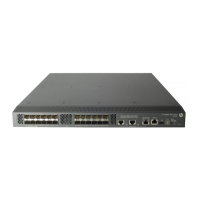33
Ste
Command
Remarks
5. Enable command
accounting.
command
accounting
Optional.
• By default, command accounting is disabled. The
accounting server does not record the commands
executed by users.
• Command accounting allows the HWTACACS
server to record all commands executed by users,
regardless of command execution results. This helps
control and monitor user operations on the device. If
command accounting is enabled and command
authorization is not enabled, every executed
command is recorded on the HWTACACS server. If
both command accounting and command
authorization are enabled, only the authorized and
executed commands are recorded on the
HWTACACS server.
• Configure the AAA accounting server before
enabling command accounting.
6. Return to system view. quit —
7. Configure
the
authenticatio
n mode.
Enter ISP
domain
view
domain
domain-name
Optional.
By default, the AAA scheme is local.
If you specify the local AAA scheme, you must perform
local user configuration. If you specify an existing
scheme by providing the radius-scheme-name
argument, perform the following configuration as well:
• For RADIUS and HWTACACS configuration, see
Security Configuration Guide.
• Configure the username and password on the AAA
server. (For more information about AAA, see
Security Configuration Guide.)
Apply
specified
AAA
scheme
to the
domain
authentication
default { hwtacacs-
scheme hwtacacs-
scheme-name
[ local ] | local |
none | radius-
scheme radius-
scheme- name
[ local ] }
Exit to
system
view
quit
8. Create a local user and
enter local user view.
local-user
user-name
Required.
By default, no local user exists.
9. Set the authentication
password for the local
user.
password { cipher
| simple }
password
Required.
10. Specifies the command
level of the local user.
authorization-
attribute level level
Optional.
By default, the command level is 0.
11. Specify the service type
for the local user.
service-type
terminal
Required.
By default, no service type is specified.
12. Configure common
settings for AUX user
interface view.
—
Optional.
See “Configuring common settings for console login
(optional).”

